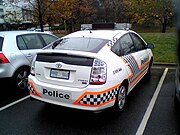Hybrid Trucks for Local Council
In his 3 December Mayoral Column ("New Hybrid Truck Helps Cut CO2 Emissions in Leichhard"on page 12 of the Inner West Courier) , Mayor of Leichhardt, Counsellor Jamie Parker, reported on the purchase of the truck for garden maintenance.Unfortunately the Mayor's message contains a typographical error in that it refers to the truck reducing Carbon Monoxide emissions by 72%. This should read "Carbon Dioxide", as indicated by the chemical symbol in the report (CO2).
Also it is not clear that a hybrid truck is not particularly suited to garden maintenance, as the Mayor suggests. Hybrid vehicles achieve greatest savings when operating at low speed in stop start traffic. A good example of such an application are garbage trucks, which stop every few metres and rarely exceed a few kilometers an hour. Local busses are another example. In contrast a garden maintenace truck spends most of its time stationary with the engine turned off, while the garden work is being done. As a result little saving is made in fuel use.
This is a good initiative, but the council might like to consider other uses for it. These trucks have a useful role by providing electrical power. One use would be for powering the hot water weed killing unit often used for roadside weeds. These are usually powered by a diesel generator mounted on the truck. With a hybrid truck the generator could be eliminated.
The council could also use the truck as an emergency generator for its disaster response. . Usually diesel generators are used for this role which require ot be specially purchased, maintained, fuelled and tested, which is expensive and environmentally unfriendly. Instead the council could have the hybrid truck fitted with a socket to allow its generator and batter to supply electrical power. This could be used for extended and extensive blackouts at council premises. It could also be used to power a mobile emergency facility., such as those provided by Salvation Army Emergency Services (SAES). The truck could also be used for power at council work sites and at community functions in parks where mains power is not avialable. The Petersham Tafe are experienced in the development of alternative power systems and should be able to advice how to do this.
Labels: alternative energy, carbon emmissions, emergency management, Hybrid, Leichhardt











